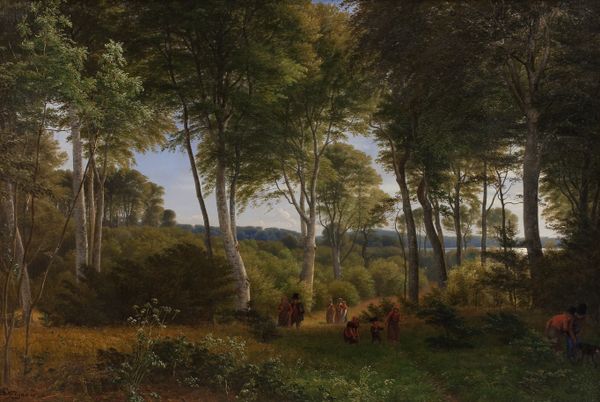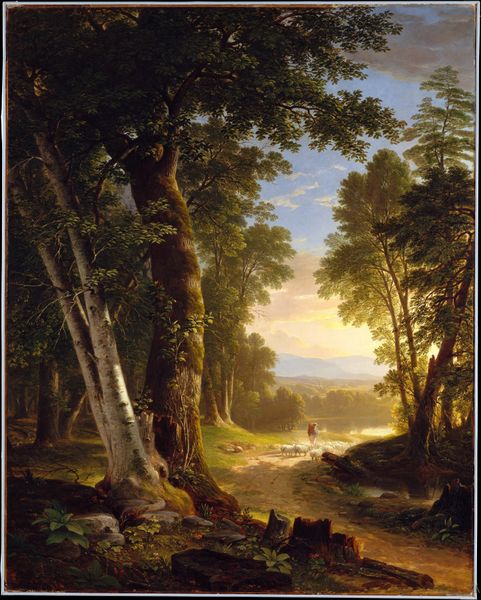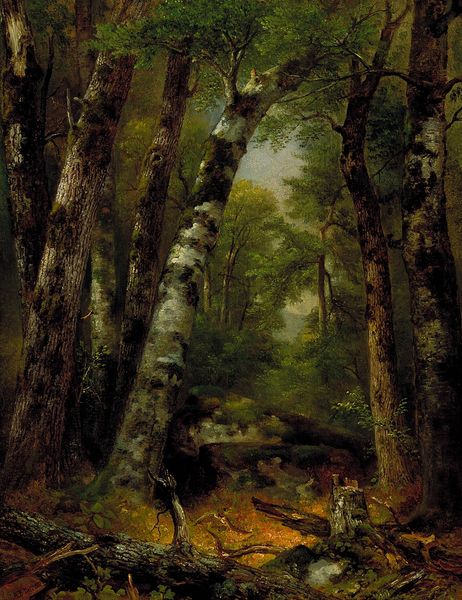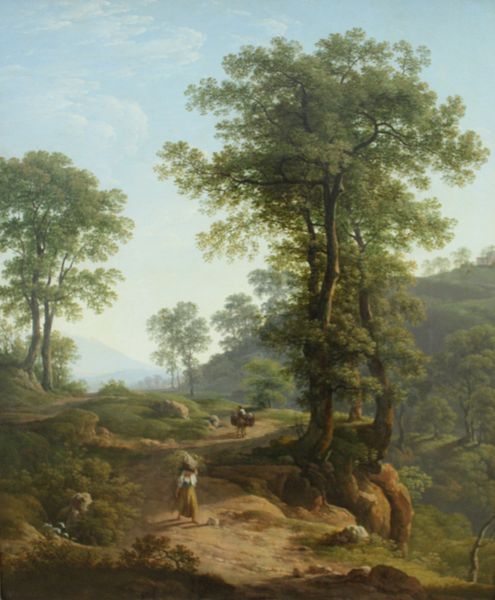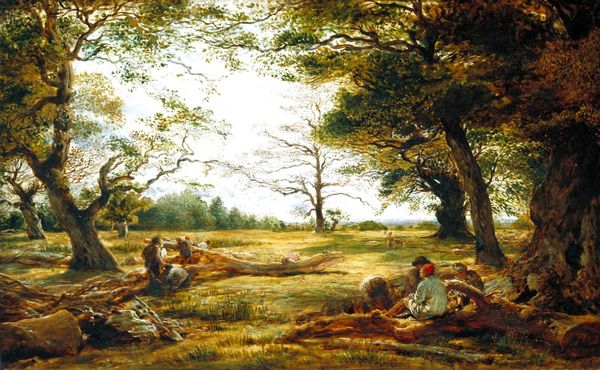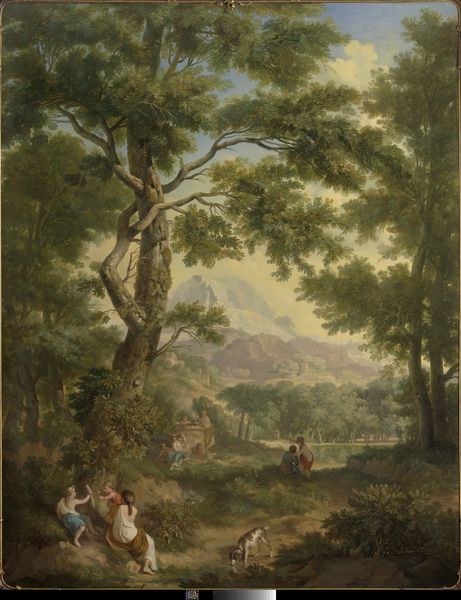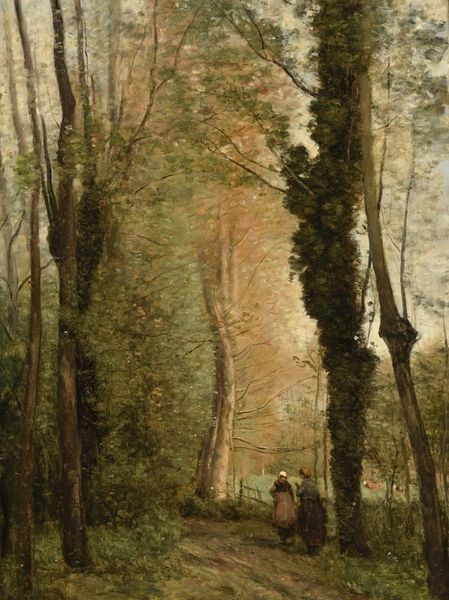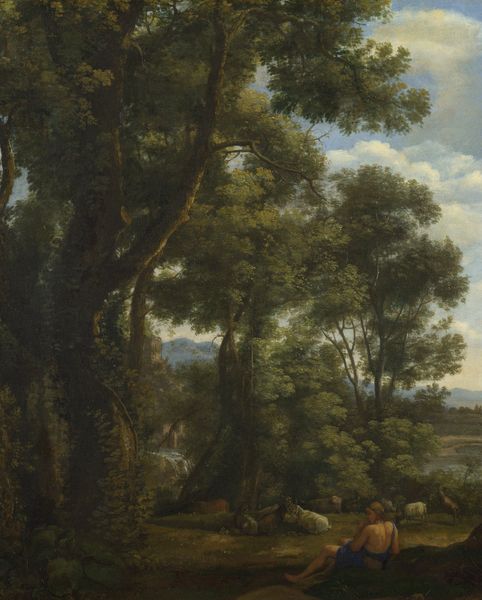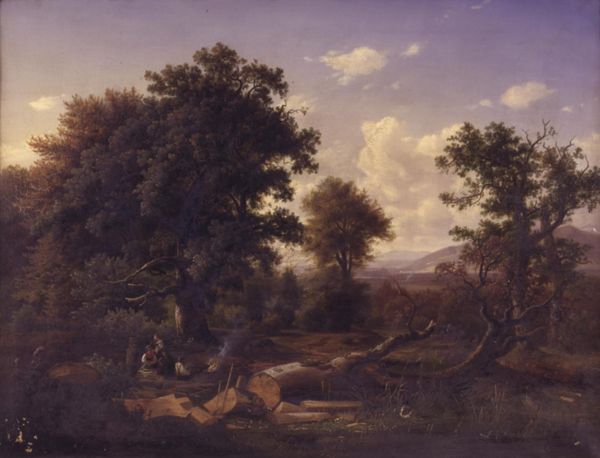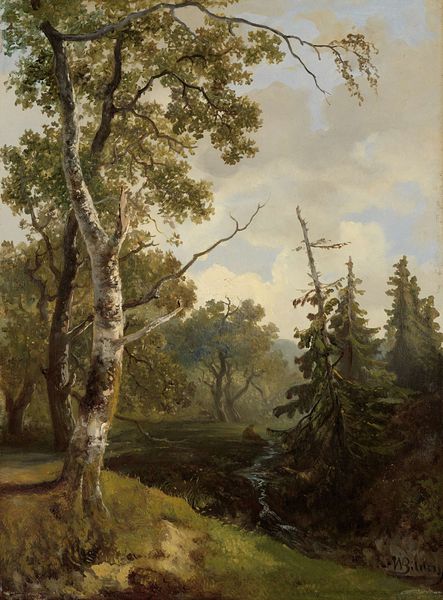
Dimensions: 189.5 cm (height) x 158.5 cm (width) (Netto), 214.1 cm (height) x 183.1 cm (width) x 11.1 cm (depth) (Brutto)
Curator: P.C. Skovgaard invites us into the serene "A Beech Wood in May near Iselingen Manor, Zealand," completed in 1857. He captures the Danish landscape en plein air on canvas. Editor: My first impression is that this painting captures a specific quality of light – a diffused, gentle illumination that softens the edges of everything within the frame. The green seems to vibrate. Curator: Skovgaard evokes powerful symbols through this light and his careful arrangement. The beech tree, a quintessential symbol of Denmark, is here a pillar of national identity, standing tall amid changing times. Consider its frequent use in Golden Age painting. Editor: And look how the composition reinforces that symbolic weight. The trees practically pierce the upper edge of the canvas, dwarfing the figures below and emphasizing the overwhelming power of nature. The path meanders, pulling the viewer's eye deeper. Curator: That's a masterful observation. The path invites us into the heart of Danishness and childhood with the children and the young woman depicted there. The figures, though small, are integral, symbolizing harmony between people and landscape—a theme central to Romanticism. Note the careful depiction of different ages there. Editor: While I see the figures as enhancing the scale, I also find the rendering of foliage particularly compelling. Note how Skovgaard renders the light filtering through the canopy? He balances precise detail with broad, almost impressionistic brushstrokes in the background, suggesting depth and atmosphere. Curator: Absolutely. It’s this masterful balance between realism and romantic idealization that cements Skovgaard's legacy. He’s not just painting a landscape; he’s painting a feeling, a sense of belonging. He uses colors, symbols and arrangement as memory and dreams. Editor: And structurally, the layering of greens from foreground to background creates a vibrant sense of recession. It shows us depth of form and compositional maturity on his part. There’s also something satisfying about the placement of the figures roughly at the golden ratio intersection. Curator: To view "A Beech Wood in May" is to see how symbols ground a nation and connect us to landscape. Editor: And it reminds us to examine, with great enjoyment, how formal structures support that message with a compelling atmospheric realism.
Comments
statensmuseumforkunst almost 2 years ago
⋮
The Danish landscape painters who had their artistic breakthrough around 1840 evinced a new attitude in their paintings. They still took their point of departure in specific motifs like their slightly older colleagues. However, they would make their chosen scenes more universal in nature, making them typical of the Danish countryside in general. When Skovgaard painted a section of the beech forest near the manor house of Iselingen on South Zealand, he depicted the specific site, but he did so in a manner that made it typical of all Danish beech forests. He very carefully selected trees that were tall, slender, and well-proportioned. The forest is not wild and impenetrable, but peaceful and airy. Like his contemporaries Skovgaard depicted nature as a place of harmony and affinity between mankind and the countryside they occupy.
Join the conversation
Join millions of artists and users on Artera today and experience the ultimate creative platform.
statensmuseumforkunst almost 2 years ago
⋮
With the endless patience of the Creator himself the artist has put leaves on all the upright beeches that tower like nature's own cathedral while dogs and people perambulate in the spring-clad woods. The motif is like a photographic rendition of its subject and was painted after the invention and breakthrough of photography, but long before it could reproduce colour. Perhaps we do not really think of this. It is simply a painting of springtime in Denmark, and you feel that you can almost go for a walk in the woods with the other people in the picture. The art of landscape painting evolved into a subtle, but effective and popular ideological and political tool in the 19th century. It was obviously different from the art favoured by the absolute monarchy of the past, full of figures, symbols, and theatrics, and A Beech Wood in May instantly became something of a national symbol. The beech forest represents the new, democratic nation that is free to rise after the abolition of absolute monarchy; a place where people can walk and speak as they please.
statensmuseumforkunst almost 2 years ago
⋮
Two girls are ambling through a light-filled, sunny beech forest; by their side is a golden-haired dog. Above the treetops the blue sky is dotted with light, white clouds. In the middle distance we see the girls' family on the grass. The delicate light green leaves are offset by the vivid red and white colours in the dress worn by one of the girls; the dress, sharing the colours of the Danish flag, epitomises the atmosphere of the entire scene: a dream of a Danish landscape drenched in sunlight and uplifted summer mood. The painting could serve as an ideal illustration for Denmark's national anthem: There is a lovely land / Its beeches broad and mighty ... The painting is a classic example of how art conveyed a new sense of national self-awareness and identity. The sheer height of the painting seems to accentuate that it was composed on the basis of a child's perspective. The pictorial space is an intimately sensed experience of walking through the beech forest, communing with the treetops above.
statensmuseumforkunst almost 2 years ago
⋮
Around 1820 the poet Adam Oehlenschläger (1779-1850) wrote his tribute to Denmark, Der er et yndigt land, which only a few decades later became the lyrics of Denmark’s national anthem. The last stanzas in the song pay homage to the beech as a symbol of the nation.The sunlit Danish beech forest as preffered motifDuring the same period, P.C. Skovgaard’s preferred motif was the sunlit Danish beech forest. He was influenced by a programme within the art scene where painting was singled out as the media chosen to communicate a new national selfawareness.However, the beech idyll in this picture is also about things closer to home, as it were. The children in the scene belong to the same family as the person who commissioned the work, the scene is set at a manor house on Southern Zealand, and the fresh and delicate green of the beech forest reflects the rich promises of childhood, of first beginnings.The painting's compositionSuch an image leaves little place for the children’s grandfather, who has quite literally been pushed into the background. In the foreground the artist minutely presents the flora found in beech forest floors, the national biotope - and the central element of the picture is the young descendent of the manor, wearing a red-white dress as a colouristic accent against all the greens.
